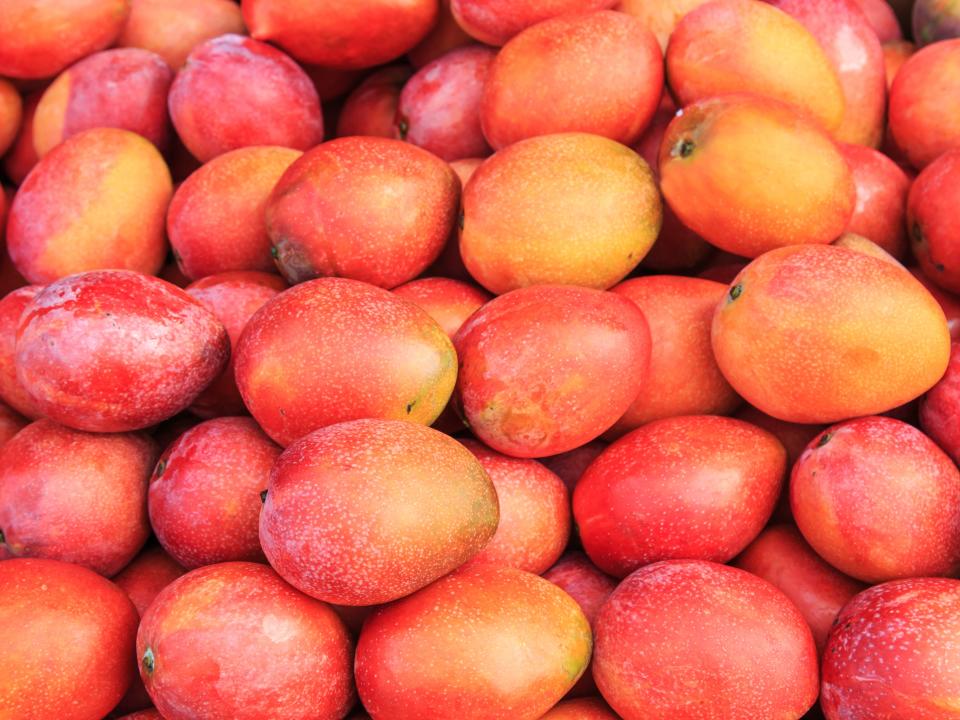Here's How to Pick the Best Mango Every Time
Mangoes are one of the few fruits that truly taste like a legit dessert. When they're good, they're perfectly custardy and creamy—basically, nature's response to créme brulée. On the other hand, a not-so-good mango tastes more like cardboard than anything else. Hard, sour, and relatively flavorless, they can be enough to make you completely forget just how amazing mangoes have the potential to be.
The good news is, most mangoes will eventually be good as long as you give them the time to ripen, and the ones that are actually bad are easy to avoid, according to Katy Green, produce field inspector at Whole Foods Market. She told SELF all about the different varieties of mangoes you'll see at your local grocery store, as well as the best ways to use them, and how to ensure they're creamy and delicious every time you dig in.
There are a lot of different mangoes you might see at the supermarket.
Unlike peaches—of which there are only a few common varieties at most grocery stores—there are a bunch of different types of mangoes you're might encounter. Green says the most common ones are Kent, Keitt, Tommy Adkins, and honey mangoes.
"Keitt are sweet and fruity and ripe when they are green," Green explains, "they do not turn the traditional mango red-orange color." Tommy Adkins are the most common type sold in the US, with a mild flavor and a sweet firm flesh (they do turn that traditional orange mango color). Kent mangoes are dark green in color with a red blush that covers only part of the fruit. As they ripen, they may develop yellow undertones or dots across the peel. And honey mangoes (which are her favorite) are small, bright yellow, and have a flattened oval shape—these are the creamiest of the bunch. You might also see them sold as champagne or ataulfo mangoes.
And there are a few different ways to use them.
Green says that Keitt and honey mangoes have fewer fibers than Tommy Adkins and Kent, which means they're better for making things like smoothies and creamy desserts. Kent and Tommy Adkins are firmer and more fibrous, which means they have a harder texture that'll hold its own in things like salads and grain bowls.
Stay away from mangoes with noticeable problem areas.
The only mangoes you really need to avoid are ones with noticeable dark spotting, bruising, or any that are super soft, says Green. From there, finding a good mango is a cinch!
Mangoes continue to ripen after they've been harvested, so go ahead and buy that hard one.
According to Green, when mangoes are picked they are hard, high in starches and acids, and low in sugars—i.e. not very tasty. Luckily, they continue to ripen as they develop ethylene gas (the gas that causes things like bananas to get sweeter over time, too). "During this process," she explains, "the fruit will start to give and the internal flesh color will change from pale yellow to a golden hue, and acidity will decrease as sugars increase."
Rather than cutting the mango open to see if its flesh has become golden, all you need do to tell if it's ripe is give it a quick squeeze. If it has some give to it, but isn't mushy it's ready to be eaten. You can use this technique for all the different varieties of mangoes. Keep in mind, more fibrous mangoes (like Kent and Tommy Adkins) will remain slightly firmer, even when they're fully ripe, whereas Keitt and honey will get much softer, and honey mangoes' skin may even slightly wrinkling in some cases.
Here are some delicious ways to use your perfect mangoes.
Mango Chia Overnight Oats

Either the softer varieties of mango or the firmer, fibrous ones will make a great addition to this pudding. If you're looking for a creamier texture, reach for a honey or a Keitt, but if you want an added bite, go for a Kent or a Tommy Adkins. Get the recipe here.
Mango, Red Quinoa, and Arugula Salad

Softer varieties of mango will turn to mush in this hearty salad, so save this one for firmer mangoes. Get the recipe here.
Mango Peanut Butter Yogurt Cup

The mango sauce in this recipe will reach its most creamiest, luscious texture if you use one of the softer varieties to make it. Get the recipe here.


